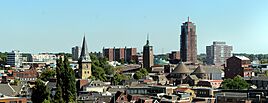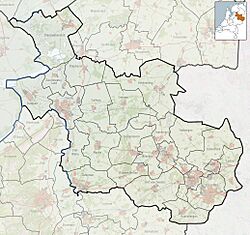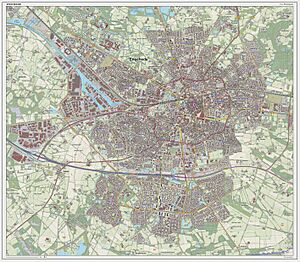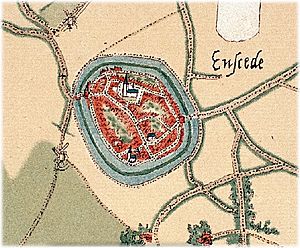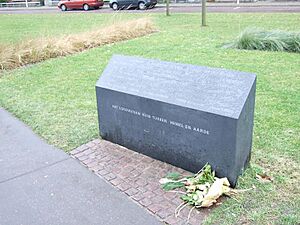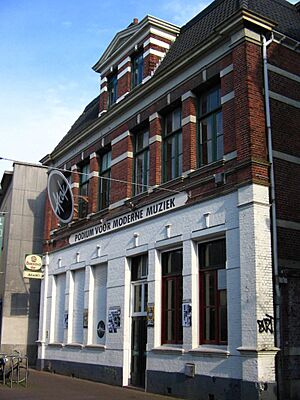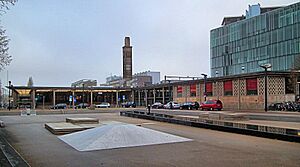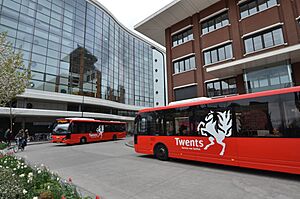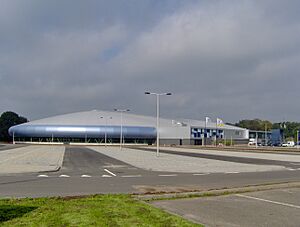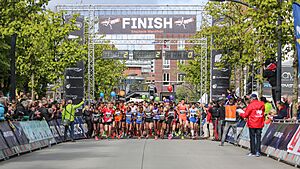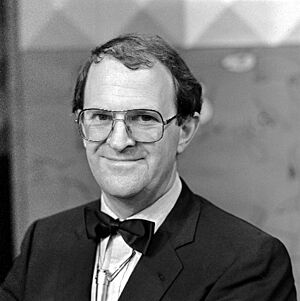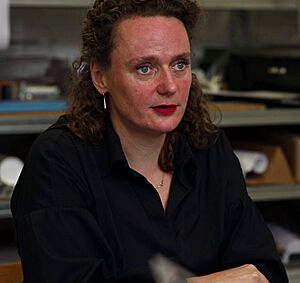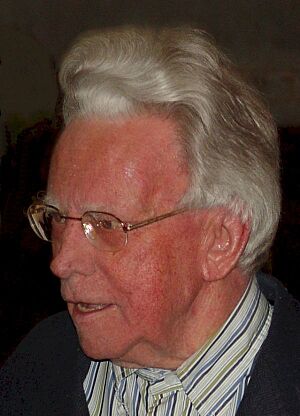Enschede facts for kids
Quick facts for kids
Enschede
Eanske (Twents)
|
|||
|---|---|---|---|
|
City and Municipality
|
|||
|
Skyline of Enschede
Rijksmuseum Twenthe
White House
Synagogue of Enschede
De Grolsch Veste
St. James Church
Historic city centre
|
|||
|
|||
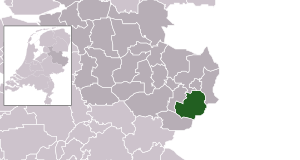
Location in Overijssel
|
|||
| Country | Netherlands | ||
| Province | Overijssel | ||
| Government | |||
| • Body | Municipal council | ||
| Area | |||
| • Municipality | 142.72 km2 (55.10 sq mi) | ||
| • Land | 141.00 km2 (54.44 sq mi) | ||
| • Water | 1.72 km2 (0.66 sq mi) | ||
| Elevation | 42 m (138 ft) | ||
| Population
(Municipality, May 2014; Urban and Metro, May 2014)
|
|||
| • Municipality | 160,341 | ||
| • Density | 1,121/km2 (2,900/sq mi) | ||
| • Urban | 158,004 | ||
| • Metro | 315,807 | ||
| • Twente | 626,586 | ||
| Demonym(s) | Enschedeër | ||
| Time zone | UTC+01:00 (CET) | ||
| • Summer (DST) | UTC+02:00 (CEST) | ||
| Postcode |
7500–7549
|
||
| Area code | 053 | ||
| Click on the map for a fullscreen view | |||
Enschede is a city and municipality in the Overijssel province of the eastern Netherlands. It is part of the Twente region. The city is very close to the German border, right next to the German city of Gronau.
Before 1935, Enschede was just the city itself. But it grew quickly with factories and railways starting in the 1860s. So, the nearby rural area of Lonneker joined Enschede to form a larger municipality.
Enschede is famous for being home to the football club FC Twente, which once won the Dutch championship. It also has the University of Twente and was the location of the last Polaroid film factory.
During the Carnival celebrations in February or March, Enschede gets a fun temporary name: Krekkelstad. This name comes from a special local cookie called a krekkel.
Contents
Exploring Enschede's Location
Enschede is located in the eastern part of the Overijssel province. It is the easternmost city in the Netherlands with more than 140,000 people. The city is only a few kilometers from Germany, which shares a border with the municipality. Some small rivers, like the Roombeek and Glanerbeek, flow through or around the city.
Enschede is divided into five main city districts. These districts also include smaller villages around the city:
- Stadsdeel Centrum (City Center and nearby areas)
- Stadsdeel Noord (including Lonneker and Roombeek)
- Stadsdeel Oost (including Glanerbrug)
- Stadsdeel Zuid
- Stadsdeel West (including Boekelo, Usselo and Twekkelo)
Enschede's Weather
Like most of the Netherlands, Enschede has an oceanic climate. This means it has mild winters and cool summers. However, because it's further inland, winters can be a bit colder than in other parts of the Netherlands. The Royal Netherlands Meteorological Institute has a weather station at the former Enschede Airport Twente, which helps them track the local weather.
| Climate data for Twenthe, Enschede (1991–2020 normals, extremes 1951–present) | |||||||||||||
|---|---|---|---|---|---|---|---|---|---|---|---|---|---|
| Month | Jan | Feb | Mar | Apr | May | Jun | Jul | Aug | Sep | Oct | Nov | Dec | Year |
| Record high °C (°F) | 14.5 (58.1) |
19.5 (67.1) |
24.5 (76.1) |
29.3 (84.7) |
31.8 (89.2) |
35.4 (95.7) |
40.2 (104.4) |
36.2 (97.2) |
32.1 (89.8) |
27.9 (82.2) |
19.8 (67.6) |
16.3 (61.3) |
40.2 (104.4) |
| Mean daily maximum °C (°F) | 5.3 (41.5) |
6.3 (43.3) |
10.1 (50.2) |
14.9 (58.8) |
18.6 (65.5) |
21.4 (70.5) |
23.6 (74.5) |
23.2 (73.8) |
19.3 (66.7) |
14.4 (57.9) |
9.2 (48.6) |
5.8 (42.4) |
14.3 (57.7) |
| Daily mean °C (°F) | 2.8 (37.0) |
3.2 (37.8) |
5.8 (42.4) |
9.6 (49.3) |
13.2 (55.8) |
16.0 (60.8) |
18.1 (64.6) |
17.6 (63.7) |
14.2 (57.6) |
10.3 (50.5) |
6.3 (43.3) |
3.5 (38.3) |
10.0 (50.0) |
| Mean daily minimum °C (°F) | -0.0 (32.0) |
−0.2 (31.6) |
1.3 (34.3) |
3.5 (38.3) |
7.0 (44.6) |
9.8 (49.6) |
12.1 (53.8) |
11.7 (53.1) |
9.1 (48.4) |
6.2 (43.2) |
3.1 (37.6) |
0.8 (33.4) |
5.4 (41.7) |
| Record low °C (°F) | −21.8 (−7.2) |
−21.8 (−7.2) |
−16.8 (1.8) |
−8.8 (16.2) |
−3.9 (25.0) |
−0.6 (30.9) |
3.0 (37.4) |
1.3 (34.3) |
−3.5 (25.7) |
−8.5 (16.7) |
−11.4 (11.5) |
−16.3 (2.7) |
−21.8 (−7.2) |
| Average precipitation mm (inches) | 70.8 (2.79) |
55.4 (2.18) |
58.1 (2.29) |
43.7 (1.72) |
57.2 (2.25) |
64.8 (2.55) |
77.6 (3.06) |
79.4 (3.13) |
67.3 (2.65) |
67.5 (2.66) |
66.1 (2.60) |
76.4 (3.01) |
784.3 (30.88) |
| Average relative humidity (%) | 87.1 | 83.9 | 78.9 | 72.6 | 73.2 | 75.2 | 76.0 | 77.9 | 83.0 | 86.1 | 89.1 | 89.1 | 81.0 |
| Mean monthly sunshine hours | 59.4 | 87.7 | 135.7 | 187.8 | 211.2 | 202.1 | 214.0 | 195.5 | 154.1 | 119.4 | 64.9 | 53.2 | 1,685 |
| Percent possible sunshine | 23.0 | 31.2 | 36.7 | 45.0 | 43.4 | 40.4 | 42.5 | 42.9 | 40.4 | 36.1 | 24.4 | 22.0 | 35.7 |
| Source: Royal Netherlands Meteorological Institute | |||||||||||||
Enschede's Past: A Journey Through Time
Early Days of Enschede
We don't know much about Enschede's very early history. But we do know that a settlement existed around the Old Marketplace a long time ago. The name Anescede or Enscede likely meant "near the border" or "near the Es" (a type of land). This early settlement had a church, a marketplace, and a strong house belonging to a noble family.
Enschede was given city rights around the year 1300. These rights were confirmed in 1325. This meant the city could protect itself with a wall. However, a stone wall was too expensive. So, Enschede used ditches, wooden fences, and hedges instead. You can still see this in street names like Noorderhagen (North Hedge) and Zuiderhagen (South Hedge). The old city layout can still be seen in the streets today.
Fires were a big problem in the medieval city because most buildings were made of wood. Major fires happened in 1517, 1750, and again in 1862. Because of these fires, people from Enschede were sometimes called Brandstichters, which means "arsonists."
The Rise of Industry
The last big fire in 1862 happened just as Enschede began to grow into a major center for making textiles (cloth). This led to a huge increase in people living in the city. By 1894, about 18,267 people lived there. At first, the city grew very quickly and without much planning.
However, in 1907, Enschede became the first city in the Netherlands to create an official plan for its growth. This plan included the nearby area of Lonneker. Textile production, which used to be a small home-based craft, became a large industry in the early 1800s. A mix of cotton and linen called bombazijn was especially popular for export. The Hardick & Seckel Factory was one of the places that made textiles in the late 1800s.
Enschede During World War II
During World War II, Enschede was one of the first Dutch cities taken over by German troops because it was so close to Germany. Many brave people in Enschede helped Jewish residents hide on farms nearby. Because of their efforts, about 500 out of 1300 Jewish people in Enschede were saved. This was a much higher survival rate than in other parts of the Netherlands.
This success was partly due to three members of the Jewish Council of Enschede: Sig Menko, Gerard Sanders, and Isidoor Van Dam. They encouraged their community to hide instead of following German orders. Another hero was Pastor Leendert Overduin, who, with his sister and others, saved hundreds of Jewish children and adults by creating a network of safe houses.
Enschede was bombed a few times during the war. The most notable bombings were on October 10, 1943, and February 22, 1944. During the first raid, the nearby airport was a target.
Changes After the Industrial Age
In the 1960s, the textile industry in Enschede completely disappeared. This meant about 30,000 people lost their jobs. Many of the old factory buildings were torn down in the 1970s and 1980s. However, some were fixed up and given new uses, like homes or museums. Enschede then started to become a city focused on services.
The city center was made into a car-free zone. In 1961, it was decided that a new technical university would be built in Enschede. This university, the University of Twente, opened in 1964.
In 2001, the city council decided to expand the built-up area into the Usseler Es, an important historical and geological site. The area of Roombeek, which was affected by a fireworks disaster in 2000, was rebuilt and finished in 2012. The spot where the factory used to be is now a monument.
The Alpha Tower was finished in 2008. This tall building has 91 apartments over 29 floors and is 101 meters high. It is the tallest building in Enschede and the entire Overijssel province.
Enschede's People and Beliefs
Religions in Enschede (2013) No affiliation (58.9%) Roman Catholic (17.1%) Protestant Church in the Netherlands (13.7%) Other Christian denominations (6.1%) Islam (3.0%) Hinduism (0.8%) Buddhism (0.3%) Judaism (0.1%)
The largest religion in Enschede is Christianity, with about 34.9% of the population being Christian.
Enschede has a large community of Assyrians. The first Assyrians came to Enschede in the 1970s, mostly from Turkey. Today, there are three Syriac Orthodox Churches in the city. These churches serve the spiritual needs of Enschede's more than 10,000 Assyrian residents.
Who Lives in Enschede?
As of 2020, Enschede had a total population of 159,640 people.
| 2020 | Numbers | % |
|---|---|---|
| Dutch natives | 111,322 | 69.7% |
| Western migration background | 20,417 | 12.7% |
| Non-Western migration background | 27,901 | 17.4% |
| Turkey | 8,758 | 5.4% |
| Indonesia | 3,282 | 2.05% |
| Morocco | 2,090 | 1.3% |
| Suriname | 1,971 | 1.23% |
| Netherlands Antilles and Aruba | 1,174 | 0.74% |
| Total | 159,640 | 100% |
Enschede's Economy and Culture
City's Economy
Enschede used to be a major center for making textiles. But when this industry moved to places where it was cheaper to produce, Enschede faced economic challenges. The city has worked hard to make itself more appealing.
New shopping centers and department stores have opened. Enschede also hosts many yearly festivals. The Old Market Square is often busy with events, live music, and other fun activities on weekends.
Being close to Germany has always been important for Enschede's economy. Many Germans visit the city's shops and weekly markets. Because of this, many people in Enschede can speak German quite well.
Enschede works with nearby cities like Almelo, Borne, and Hengelo as part of Netwerkstad Twente. This is a way for them to cooperate and grow together.
The famous Grolsch beer is brewed in Enschede. Also, the tire company Apollo Vredestein B.V. has its main office and a factory in the city. This company is one of the biggest employers in the region.
Culture and Arts in Enschede
Museums in Enschede
Enschede has several museums. One important museum is the Rijksmuseum Twenthe, which displays art. There is also De Museumfabriek (formerly TwensteWelle). This museum combines the cultural history of Twente with its natural history. It's a unique combination for the Netherlands. The museum opened in April 2008. It is partly located in an old textile factory, which reminds visitors of Enschede's textile past.
Music and Theater
Music in Enschede has been shaped by its close ties with Germany and its history in the textile industry. Over the years, many different music groups have formed, from small string quartets to large symphony orchestras. Jazz music also became popular here starting in the 1920s.
Enschede has three main places for classical music concerts: the Muziekcentrum, the Twentse Schouwburg, and the Grote Kerk. They are now known together as Wilminktheater en Muziekcentrum Enschede. They offer a variety of concerts, theater shows, and performances for young people.
In November 2008, the Nationaal Muziekkwartier opened. This large building near the Central Station brings together a new theater, the pop music venue Atak, the ArtEZ Conservatory, and the Dutch Symphony Orchestra.
In December 2012, the national radio station 3FM held its "Serious Request" charity event in Enschede. They raised over 12.2 million euros (almost 16.2 million US dollars) for a good cause.
Getting Around Enschede
Train Travel
Enschede is the end of the line for trains coming from the west of the Netherlands. You can take trains from Enschede to cities like Hengelo, Almelo, Zwolle, and even to Schiphol Airport and The Hague.
To the east, there's a train line that goes into Germany, to Gronau. This line also has two more stations in the Netherlands: Enschede De Eschmarke and Glanerbrug. German trains travel on this line to Münster and Dortmund.
It's interesting to note that the train tracks from the Netherlands and Germany don't connect in Enschede. There's a small gap between them. This means Enschede is a "double terminus station."
There is also the Enschede Kennispark railway station, which is close to the football stadium.
Bus Services
Enschede has a network of bus lines that connect almost every part of the city to the center. You can also take buses from Enschede to nearby towns and cities like Hengelo and Oldenzaal. The city bus lines are run by Syntus.
Air Travel
Enschede used to have a combined civil airport and military airbase called Enschede Airport Twente. The military part closed in 2007, and the civil airport closed in 2008. However, it is still used for business flights, private jets, and recreational flights.
Roads in Enschede
Around the central parts of Enschede, there is a circular road about 8 km long. People often call it "de singel." This road was built between 1916 and 1929. Most major roads connect to this ring road. Enschede is connected to the national road network by the A/N35 and the N18.
There are many parking areas near the city center. The largest and most famous is the Van Heekgarage, which is an underground parking garage. It is the biggest underground parking garage in the Netherlands, with space for 1650 cars.
Sports in Enschede

Enschede's main association football club is FC Twente. They won the top Dutch league, the Eredivisie, in 2010. Their home stadium is De Grolsch Veste, which can hold over 30,000 fans.
The Enschede Marathon is a very old and famous race. It is the second oldest marathon in Europe and the oldest in the Netherlands, held every year since 1947.
Enschede also has IJsbaan Twente, which is an indoor speed skating arena. It was the second one built in the country.
Enschede's Sister Cities
Enschede is twinned with these cities around the world:
 Dalian, People's Republic of China, since 2009
Dalian, People's Republic of China, since 2009 Münster, Germany, since 2021
Münster, Germany, since 2021 Palo Alto, California, United States, since 1980
Palo Alto, California, United States, since 1980
Famous People from Enschede
- Harry Bannink (1929–1999) - A Dutch composer, who wrote music.
- Willem Wilmink (1936–2003) - A Dutch poet and writer.
- Jan Cremer (born 1940) - A Dutch author, photographer, and painter.
- Hansje van Halem (born 1978) - A Dutch graphic designer.
- Bracha van Doesburgh (born 1981) - A Dutch actress.
- Heiko Wierenga (1933–2013) - A Dutch politician and Mayor of Enschede for many years.
- Jan Mans (born 1940) - Another Dutch politician who served as Mayor of Enschede.
- Paul Polman (born 1956) - A Dutch businessman who worked for big companies like Unilever.
- Wiebe Draijer (born 1965) - A Dutch engineer and CEO of Rabobank.
- Hans Schnitger (1915–2013) - A field hockey player who competed in the Olympics.
- Paul Hoekstra (born 1944) - A sprint canoeist who won a silver medal at the 1964 Summer Olympics.
- Jan Jeuring (born 1947) - A former professional football player for FC Twente.
- Johan Reekers (born 1957) - A Dutch athlete who competed in the Paralympics eight times.
- Henk-Jan Zwolle (born 1964) - A former rower who won bronze and gold medals at the Olympics.
- Jeroen Heubach (born 1974) - A former football player.
- Bas Nijhuis (born 1977) - A Dutch football referee and also a baker.
- Rianne Guichelaar (born 1983) - A water polo player who won a gold medal at the 2008 Summer Olympics.
- Jorien ter Mors (born 1989) - A Dutch speed skater who won gold medals at the Winter Olympics.
- Larry ten Voorde (born 1996) - A Dutch racing driver.
Images for kids
See also
 In Spanish: Enschede para niños
In Spanish: Enschede para niños


